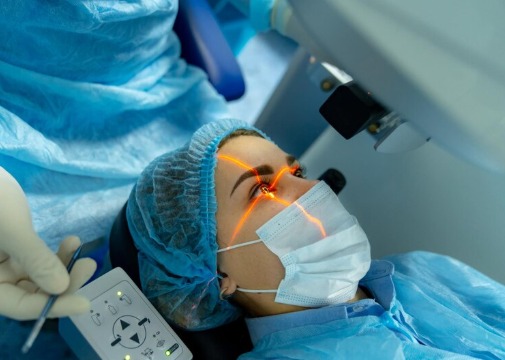Once a sci-fi fantasy only seen in futuristic movies, it has subtly made its way into the mainstream of cosmetics. By removing layers of melanin, iris depigmentation laser surgery—yes, it is a real procedure—promises to completely lighten dark eyes. It’s a dream come true for some people. Others find the risk too great to bear.
In order to expose the lighter eye colors—blues, greens, and hazels—that lie beneath, doctors are now using ultra-precise laser pulses to target the anterior stroma of the iris, which disperses melanin clusters. It’s neither a temporary filter nor a colored lens. It’s a permanent alteration that is engraved into the very framework of your eyes.
| Procedure Name | Laser Iris Depigmentation Surgery |
| Also Known As | Photoablative Iridoplasty, Laser Iridoplasty |
| Purpose | Cosmetic eye color change (lighten iris pigmentation) |
| Mechanism | Laser targets and breaks down melanin in iris stroma |
| Duration | Outpatient; typically several sessions over weeks |
| Benefits | Permanent eye color change without implants or dyes |
| Risks | Glaucoma, uveitis, vision impairment, irreversible effects |
| Cost | $5,000 – $10,000+ (varies by clinic and country) |
| Notable Clinic | NEWEYES by Clínica Eyecos |
| Regulatory Status | Not FDA approved; legal status varies by country |
| Celebrity Influence | Speculated, but not officially confirmed |
The NEWEYES technique was created by pioneers at Clínica Eyecos in Barcelona. It uses a frequency-doubled Nd:YAG laser to gently eliminate pigment while protecting the deeper ocular tissues. Proponents claim it is a safer option than keratopigmentation or iris implants, which have been the subject of years’ worth of medical warnings. However, “safer” does not always equate to “safe.”

Patients are frequently informed during consultations that the lighter shade that is exposed is their “true” eye color, which is just concealed by pigment. That concept alone has a transformative effect on many. Though psychologically taxing, the idea of unearthing something hidden—something beautiful—is incredibly alluring.
First-hand accounts have been flooding TikTok feeds and Reddit forums in recent months. Dark brown eyes are seen turning icy blue or hazel green in before and after photos. Some say they are ecstatic about their change. Others relate stories of uncomfortable pressure spikes, floaters, and persistent dryness. Some even apologize, saying that their eyes “no longer feel like theirs.”
The method gradually eliminates pigment particles by using a selective laser ablation process. However, risks are still very real because lasers operate in such a delicate area. Cases of maculopathy and secondary glaucoma were recently reported in the Canadian Journal of Ophthalmology. The current corpus of safety research has been deemed “insufficient” by the U.S. NIH.
Interest has not diminished as a result. Insider rumors indicate that the procedure’s adoption among influential individuals, actors, and even cryptocurrency entrepreneurs is increasing steadily, despite the fact that few celebrities have gone on record. It makes sense that few people are willing to publicly acknowledge having surgery that many still consider to be morally and medically dubious.
For some, the decision is aspirational rather than merely aesthetic. In fashion and movies, lighter eyes have long been fetishized as being uncommon, enigmatic, or naturally beautiful. The option to permanently alter one’s eye color speaks volumes about the pressures people silently carry in a cultural environment still struggling with colorism and Eurocentric standards.
Iris depigmentation makes more than just a cosmetic procedure in this situation; it becomes a statement. a representation of social dynamics. An audacious, unchangeable declaration.
Innovation is still going strong, though. In order to better target pigment granules while reducing inflammation, recent prototypes are investigating improved eye tracking and more intelligent energy modulation. The upcoming class of lasers is already demonstrating encouraging gains in accuracy and recovery following surgery, according to CRST Global.
Meanwhile, uncontrolled clinics are opening up in areas with laxer regulations, such as parts of the Middle East, Turkey, and Colombia. They rarely offer comprehensive aftercare or long-term monitoring, despite frequently advertising prices that are almost 40% less than those of European centers. The savings can be exorbitant for patients looking for a deal.
These pop-up clinics use viral video testimonials to market dreams in a stunningly straightforward way. However, dreams that bear the burden of permanent change should be accompanied by strong caution, and ideally, regulation.
